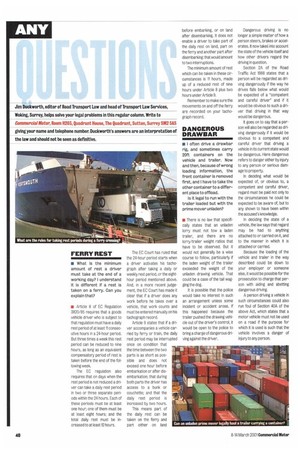DANGEROUS DRAWBAR
Page 42

If you've noticed an error in this article please click here to report it so we can fix it.
II I often drive a drawbar rig, and sometimes carry 20ft containers on the vehicle and trailer. Now and then, because of wrong loading Information, the front container is removed first, and I have to take the other container to a different place to offload.
Is It legal to run with the trailer loaded but with the prime mover unladen?
• There is no law that specifically states that an unladen lorry must not tow a laden trailer, and there are no lorry/trailer weight ratios that have to be observed. But it would not generally be a wise course to follow, particularly if the laden weight of the trailer exceeded the weight of the unladen drawing vehicle, That could be a case of the tail wagging the dog.
It is possible that the police would take no interest in such an arrangement unless some incident or accident arose. If this happened because the trailer pushed the drawing vehicle out of the driver's control, it would be open to the police to bring a charge of dangerous driving against the driver. Dangerous driving is no longer a simple matter of how a person steers, brakes or accelerates. It now takes into account the state of the vehicle itself and how other drivers regard the driving in question.
Section 2A of the Road Traffic Act 1988 states that a person will be regarded as driving dangerously if the way he drives falls below what would be expected of a "competent and careful driver" and if it would be obvious to such a driver that driving in that way would be dangerous.
It goes on to say that a person will also be regarded as driving dangerously if it would be obvious to a competent and careful driver that driving a vehicle in its current state would be dangerous. Here dangerous refers to danger either by injury to any person or serious damage to property.
In deciding what would be expected of, or obvious to, a competent and careful driver, regard must be paid not only to the circumstances he could be expected to be aware of, but to any shown to have been within the accused's knowledge.
In deciding the state of a vehicle, the law says that regard may be had to anything attached to or carried on it, and to the manner in which it is attached or carried.
Because the loading of the vehicle and trailer in the way described could be down to your employer or someone else, it would be possible for the prosecution to charge that person with aiding and abetting dangerous driving.
A person driving a vehicle in such circumstances Could also run foul of Section 40A of the above Act, which states that a motor vehicle must not be used on a road if the purpose for which it is used is such that the vehicle involves a danger of injury to any person.
































































































